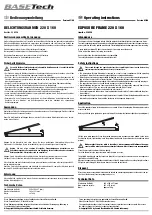
PGM – appears while you program frequencies into the scanner’s channels.
(key symbol) – appears when you lock the keypad.
ch – appears after the digits (1-50) that show which channel the scanner is tuned to.
-d – appears during a direct frequency search.
000.000 – the digits on the right of the display show which frequency the scanner is tuned to.
Error – appears when you make an entry error.
dUPL (duplicate) – appears when you try to store a frequency that is already stored in another channel.
UNDERSTANDING BANDS/MONITOR MEMORY
Search Bands
Your scanner can tune over 34,000 different frequencies. Many of these frequencies are grouped within
permanent memory locations called search bands.
Band
Displayed Search Range (MHz)
Description
0
68-78
VHF Lo
1
78-88
VHF-Lo
2
137-144
Aircraft/Air Shows, VHF
3
144-148
2-Meter Amateur Radio
4
148-174
VHF Hi
5
380-420
UHF Lo
6
420-450
70-Centimeter Amateur Radio
7
450-512
UHF Lo
8
806-870
UHF „T“ Band
9
870-960
UHF Hi
You can search these bands to quickly find active frequencies you might want to store into the scanner’s
channels. For example, if you wanted to search for transmissions between amateur radio operators,
you could search only the search bands where you are most likely to hear the transmissions (Bands 3,
and 6).
Note: The frequencies in the scanner’s search bands are preset. You cannot change them.
Monitor Memory
The scanner also has a monitor memory that you can use to temporarily store a frequency while you
decide whether to save it into a channel. This is handy for quickly storing an active frequency when you
are searching through an entire band using direct search. See „Direct Search“.
































